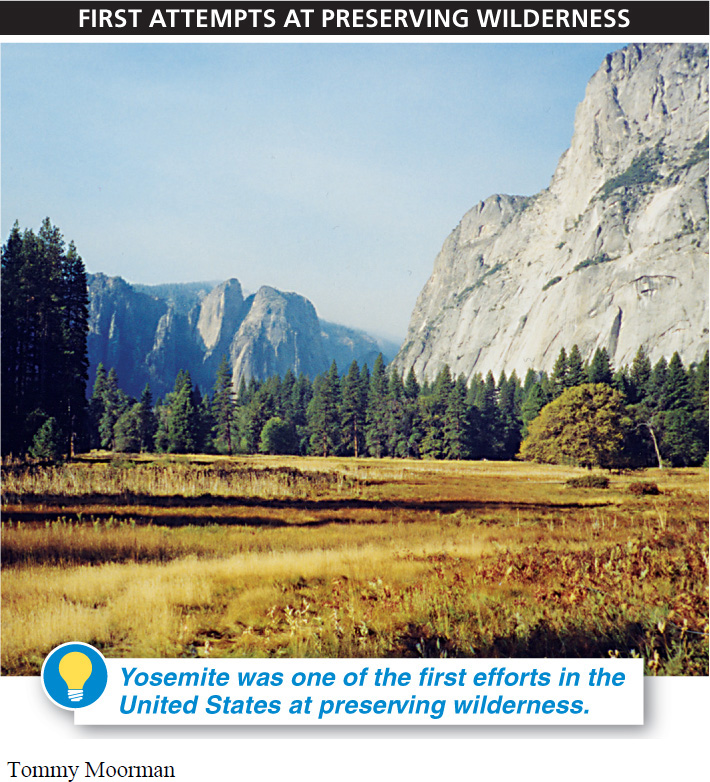In a survey asking which animal they would like to be, men and women gave very different answers. Among men, the top answer was eagle, followed by tiger, lion, and dolphin. As their first choice, women chose cat, followed by butterfly, swan, and swallow. It’s just a silly survey, but the differences in male and female selections parallel the fact that people have very different preferences when it comes to preserving biodiversity. One person may view as unthinkable the loss of a particular species or habitat, while another may view other species or habitats as much more valuable.
Most approaches to conservation biology, as we’ve seen, have focused on the preservation of individual species. Increasingly, however, conservation biology is shifting toward the preservation of important habitats, focusing on conserving communities and ecosystems. This habitat-
One example of an effort aimed at the preservation of important habitat is the World Wildlife Fund’s “Global 200,” an identification of all of the most biologically distinct habitats on earth. The identification of these habitats, which include terrestrial, freshwater, and marine habitats, is part of an innovative strategy, often called landscape conservation, that is geared toward conserving not just species but habitats and ecological processes (e.g., large-
The habitat conservation approach is not new. The very first attempts at conservation in the United States were the creation of Yellowstone Park in 1872 and Yosemite in 1890, both large-

As conservation biologists have started to better understand population dynamics and biogeography, the design of natural preserves has evolved. Modern preserve design focuses not simply on maximizing the variety of habitats and biodiversity preserved but on using several design features that maximize the efficiency of the preserves (FIGURE 16-36).

- Larger, rather than smaller, preserves (including a preference for a single, undivided preserve over several smaller preserves)
- Circular, rather than linear, preserves to reduce the negative effects at the preserve edges
- Corridors—
even just relatively narrow strips of land— that connect larger natural preserves, allow gene flow, and reduce inbreeding among distinct populations in the different preserves - Buffer zones (which permit limited amounts of human activity) around core areas (which contain the habitat to be conserved)
As conservation plans aimed at preserving habitats increase, efforts focusing on individual species still continue to be effective. Several strategies targeting individual species for conservation have been particularly successful at preserving large amounts of biodiversity beyond that single species.
1. Flagship species. Some species, because they are particularly charismatic, distinctive, vulnerable, or otherwise appealing, can engender significant public support. Examples include the giant panda of China, the golden lion tamarin of Brazil’s coastal forest, the mountain gorilla of Central Africa, the orangutan of Southeast Asia, the leatherback sea turtle, the Indian tiger, and the African elephant. Preservation of these species, given their habitat needs, can serve to preserve many other species as well.
679
2. Keystone species. As we saw in Chapter 15, keystone species have a disproportionate effect on the biodiversity of a community. Their removal can lead to massive changes in the composition of species in an ecosystem, often causing huge loss of biodiversity. Examples include kelp, California mussels, grizzly bears, beavers, and sea stars.
3. Indicator species. These are species whose presence within an ecosystem indicates the presence or well-
4. Umbrella species. These include wide-
For the most critically endangered species and degraded habitats, all hope is not necessarily lost. Captive breeding programs and habitat restoration have had some success in bringing back biodiversity from the brink of extinction. Zoos and botanical gardens have taken the lead in many of these efforts. In the 1980s, for example, when the population size of the California condor had dropped to 22 individuals, due to poaching, lead poisoning, and habitat loss, all of the birds were caught and taken to zoos, where a captive breeding program began. With the success of these breeding programs, by 2011 the population had reached 400, including close to 200 birds in the wild and the remainder in zoos. Breeding programs are not a complete conservation solution on their own, however. It is essential that the species’ habitats are not destroyed or altered if the species are to flourish again under natural conditions.
Restoration ecology, which uses the principles of ecology to restore degraded habitats to their natural state, has also been an important tool of conservation biologists. Wetlands that have been degraded by dredging and development, in particular, have benefited. Reintroduction of the native plant species and restoration of water and stream flow patterns can be instrumental in restoring these habitats.
Taken together, the strategies used by conservation biologists represent an important step toward reducing the adverse effects of one hugely successful (from a population growth perspective) species—
TAKE-HOME MESSAGE 16.14
Conservation biology has focused, in the past, on preserving individual species. Increasingly, there is a shift toward the preservation of important habitats, focusing on conserving communities and ecosystems. Several methods focusing on single species remain useful, however, particularly when preserving the selected species requires the preservation of an amount and type of habitat that simultaneously preserves many other species.
The preservation of particularly distinctive, charismatic flagship species, such as the panda or mountain gorilla, can engender significant public support. Furthermore, preserving their habitats can serve to preserve many other species as well. Describe one of the other three strategies that has been particularly successful at preserving large amounts of biodiversity beyond a single species.
(1) Preservation of keystone species is particularly important, because their loss can lead to massive changes in the composition of species in an ecosystem. (2) Preservation of indicator species, whose presence is an indicator of air or water quality, helps to preserve conditions that make an ecosystem healthy. (3) The preservation of wide-ranging umbrella species with large needs for habitat and other resources results in the protection of numerous other species within the same habitat.
680